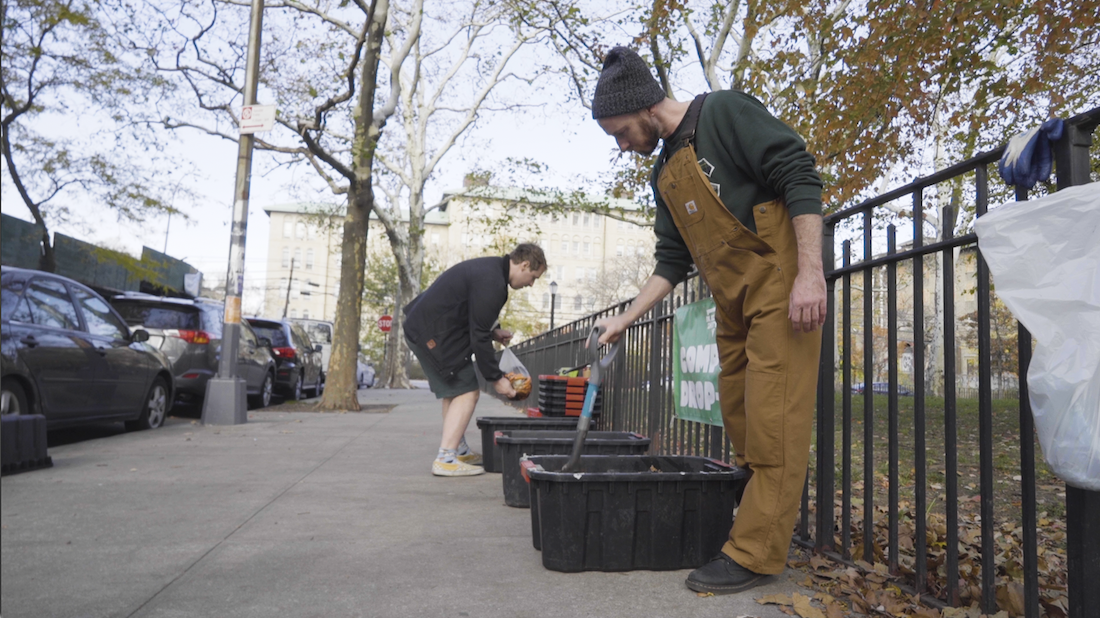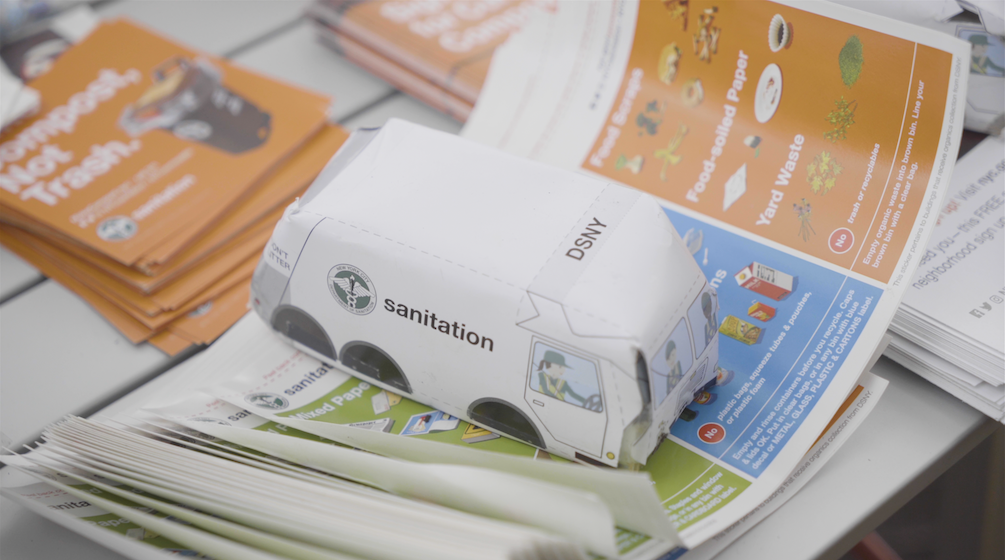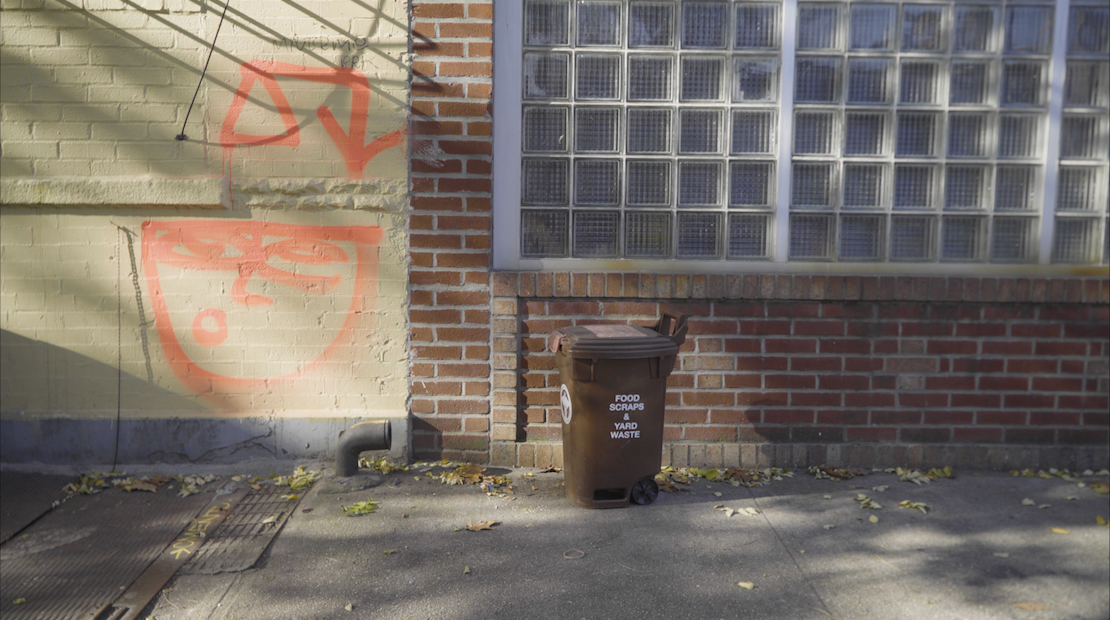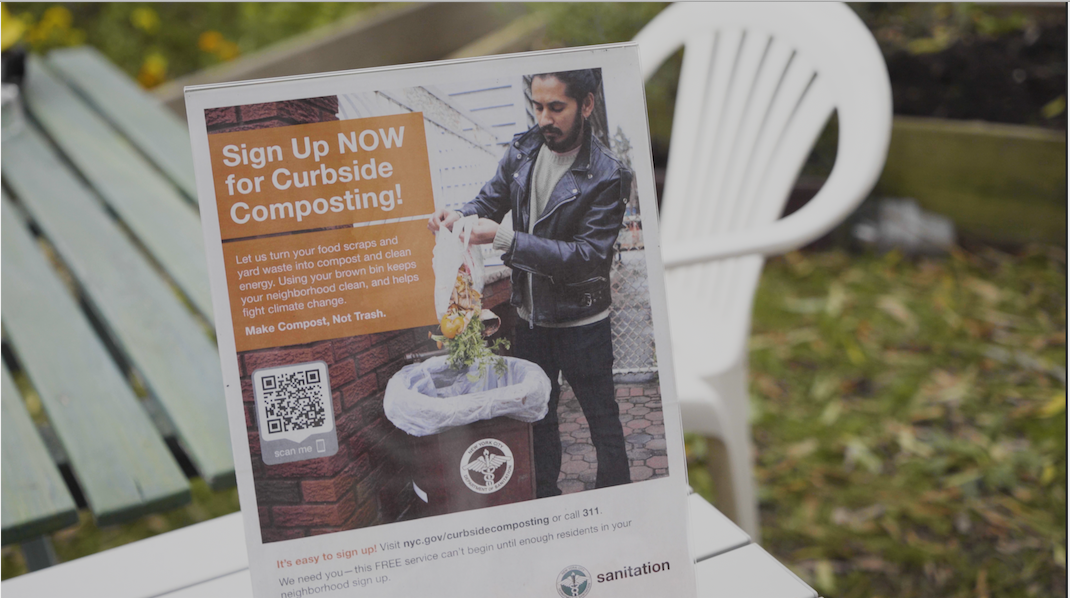The Winding Journey of Brown Bins
By Jiale Hu
A One-Man Trash Shuttle

Clay Burch volunteering at Brooklyn Scraps Shuttle on November 21, 2021.
Clack, clack, clack.
Every Sunday outside of Cooper Park in East Williamsburg, there is a clattering sound. It’s always Clay Burch, shoveling frozen compost consisting of banana peels, coffee grains, and chopped vegetables.
The clacking sound is often interrupted by greetings from neighbors who come to drop off their food scraps. Occasionally, people ask if he’s here every weekend. Burch answers yes.
A freelance photographer in Brooklyn, Burch has volunteered to arrange a compost pick-up site called “Brooklyn Scrap Shuttle” almost every Sunday from 12-3 pm since May 2020 (the schedule changed to 12-2 pm since October 24, 2021). Burch’s consistent volunteering of his time, though beneficial to communal bonding in East Williamsburg, exists because of an unexpected event.
“I found out that they were no longer going to be picking up compost. And I was like… I can do it.” said Burch.
“They” refers to the New York City Department of Sanitation (DSNY). In April 2020, DSNY announced the suspension of Curbside Composting Program due to pandemic-induced budget cuts. The curbside collection of trash and recyclables were not affected.
A Citywide Truck Disappearance
Starting its pilot phrase in 2013, DSNY’s Curbside Composting program introduced brown bins for residents to discard their organic waste separately. By early 2020, the program expanded to 44 out of 59 community boards across all five boroughs.
Each building with less than 10 units automatically received the brown bin for weekly organic waste pick-ups.
That all changed when COVID-19 hit. The Department of Sanitation took a cut of $106 million, $24.5 million of which belonged to organics recycling. The priority shifted instead with $190 million in federal funding to DSNY for emergency food delivery.
“We are just…subject to the needs and pressing issues of the day,” said Hillary Bosch, the DSNY Brown Bin Community Outreach Coordinator.
Beginning in May 2020, trucks stopped coming for the brown bins.
Yet you still see them sitting on the New York City curbside. These brown bins look like grills displaced in winter or heaters in the summer—off-season tools that hold a vague promise of productivity in an indefinite future. They come in different sizes too. The bins with smaller sizes, almost half as tall as the blue and green bins next to them, look especially like decorations.
They were a part of the success story of how the Department of Sanitation moved towards Mayor Bill de Blasio’s goal of Zero Waste to landfills by 2030.
In the fiscal year of 2019, these brown bins diverted 154.7 tons of organic residential waste every day from landfills. This was a small step that decreased 0.7% of the daily organic residential waste. Given the same neighborhood coverage, DSNY Curbside Composting Program saw a significant increase of 12.6% tonnage collected from 2018 to 2019.
The defunding in 2020, unfortunately, paused the growth.
The annual reports for DSNY Curbside Collections show that citywide organic waste collection dropped from 154.7 tons to 6.6 tons per day from FY2019 to FY2021.
A 95% decrease of tonnage collected seems to have outdone the growth harvested over the past six years.

Layout of DSNY outreach materials
Why NYC Cares about Composting
In the Department of Sanitation’s latest Waste Characterization Study in 2017, organic waste consisted of 34% of the total residential waste of New York annually. Chances are, these organic waste such as fruit peels and dry leaves end up having the same destiny with regular trash. Together, they travel to remote landfills and get buried underground in Central New York, Pennsylvania, Virginia, and South Carolina.
For DSNY, landfills are costly trips. The annual cost of waste exports is $430 million in 2020, ranking as the fourth largest expenditure category, according to the New York City Council.
Moreover, landfill is the third biggest contributor to methane emission in the United States, amounting to 114.5 Million metric tons of CO2.
Separating the organic waste from the landfilled regular trash is ideal from an environmental and financial standpoint. Project Drawdown from Princeton University shows that the shift from landfilling to composting organic waste can reduce more than 50% of carbon dioxide-equivalent greenhouse gas emissions.
To Bin or Not to Bin: a Winding Journey
While the benefits of composting are straightforward, effective implementation takes a much more winding journey in the city.
In 1991, DSNY started with an “Intensive Zone Pilot” of 22,000 households in Brooklyn Community District 6, crossing Park Slope, Carroll Gardens and Gowanus. Two years later, the Department established a second intensive zone in a section of Starrett City in Brooklyn. In these zones, residents separated their own organic waste, and the Department of Sanitation sent them to the centralized facilities.
Similar to the Brown Bin program, these preceding intensive zone pilots are experiments of “centralized composting.”
The pilots were found to be inefficient in a 2011 program review. Amid challenges such as a high contamination rate, the cost of transporting the material was very high. Since each household had a small amount of organic waste, the high cost of developing new pick-up trucks could not be justified.
This gave birth to other “decentralized composting” experiments and outreach efforts.
In 1994, the longest running food scrap drop-off site launched at the Lower East Side ecology center. Four years later, the Backyard Compost Bin Pilot Program launched. In 2000, the first “Master Composter” course in the Bronx began to foster resident-run home and neighborhood composting sites instead of relying on municipal processing facilities. With these initiatives, DSNY assisted in fostering a composting culture among New Yorkers.
A harder look at centralized composting came in 2010, when the City Council passed Local Law 42 that requested an updated Assessment of Composting Opportunities for “composting a larger portion of the organics in NYC’s waste system.”
This was how the Brown Bin Curbside Composting Program came along in 2013.
An Absence Hard to Fill

A brown bin left on the street in East Williamsburg in November 2021.
Carrying a DSNY brown bin on his skateboard, Hunter Stark approaches the drop-off site at Cooper Park. “It still does the job,” says Stark with a smile as he pours the food scraps into one of the collecting bins of Brooklyn Scraps Shuttle.
The annual difference of more than 54,000 tons of organic waste needed somewhere else to go.
DSNY suggested that regular trash was the option.
New Yorkers dedicated to composting tried to look for other alternatives. Similar to the 1990s when centralized composting program , decentralized composting such as local community drop-off sites have become even more significant in the city’s composting ecosystem.
The Green Markets hosted by Grow NYC had 76 pop-up sites available every week across the City by February 2020; however, this alternative stopped also during the citywide shutdown in March 2020.
It never returned to its full scale due to budget cuts.
“In April, we were told that we would simply have no funds for the fiscal year of 2020,” said Emily Bachman, the Assistant Director of Compost Program at Grow NYC.
Funded by the Sanitation Department, Grow NYC’s community compost drop-off services were on complete hold. Fortunately, the Save Our Compost coalition brought back less than 10% of the budget for composting programs in the City.
“That was totally just citizen advocacy,” said Bachman. “our portion of it was $500,000…about a quarter from the year before.”
Instead of 76, 16 compost drop-off sites by Green Markets were available for the entire year from September 2020 to September 2021.
Another alternative is community gardens that are independent of government funding. Often restricted to only members of the gardens, they also fail to meet a rising demand for composting.
“During the pandemic, we had many who wanted to drop their compost at our garden,” said Charlotte Bell at Red Shed Community Garden in East Williamsburg. “Really we can only handle what our members bring in.”
Other than compost drop-off sites offered by NGOs and community gardens, individual initiatives such as Brooklyn Scrap Shuttle might be the only option for some.
The Journey Continues

Sign-up poster displayed in Red Shed Community Garden on October 31, 2021.
“Have you heard about the return of Curbside Composting?” Clay Burch asked some neighbors who walked to dump the food waste. The answers varied.
“Yeah. I already signed up. Got an email that says on December 7.”
“Not yet… when will they come?”
“Did they push it from October to December?”
With a new fiscal year approaching, DSNY announced the return of brown bin pick-up services in April 2021. Seven out of 44 community boards that previously had brown bins now receive Curbside Composting again as of December 2021.
“With the limited budget, we are tasked to roll out at neighborhoods that would have the most interest, with the highest predictable tonnages,” said Bosch from DSNY.
To determine the interest level of community boards, New Yorkers need to sign up either on the DSNY website or through calling 311. The sign-up system assists the Department of Sanitation to conduct a monthly review of sign-ups, population density, household sizes, efficiency of route-planning and other factors.
Internally, this review helps the Curbside Composting team to coordinate new roll-out routes with other counterparts within DSNY. Externally, mapping sign-up interests also helps DSNY to request more funding to serve more neighborhoods.
At the current pace, such recovery struggles to meet a seemingly growing interest in composting.
A new convert to composting since 2020, Steve Lewis is a resident of East Williamsburg. He was trapped at home to cook more because of COVID-19. “I saw how much food waste I generated every day,” said Lewis, “and that turned on my switch.”
There is no comprehensive tracking of how many New Yorkers want to compost now versus before the pandemic. However, different compost collectors have witnessed an increase in active participation.
“Our sites have increased in participation anywhere between 50% and 300%,” said Bachman from Grow NYC. This exponential growth may also result from fewer composting sites.
Clack, clack, clack.
By Cooper Park, Burch is still chopping the frozen composts. Now that the brown bin service returns to East Williamsburg, he has not decided when to end Brooklyn Scraps Shuttle.
“It depends on how many people will keep bringing their food scraps to me,” said Burch. “At least do it through December… then I will reassess from there.”